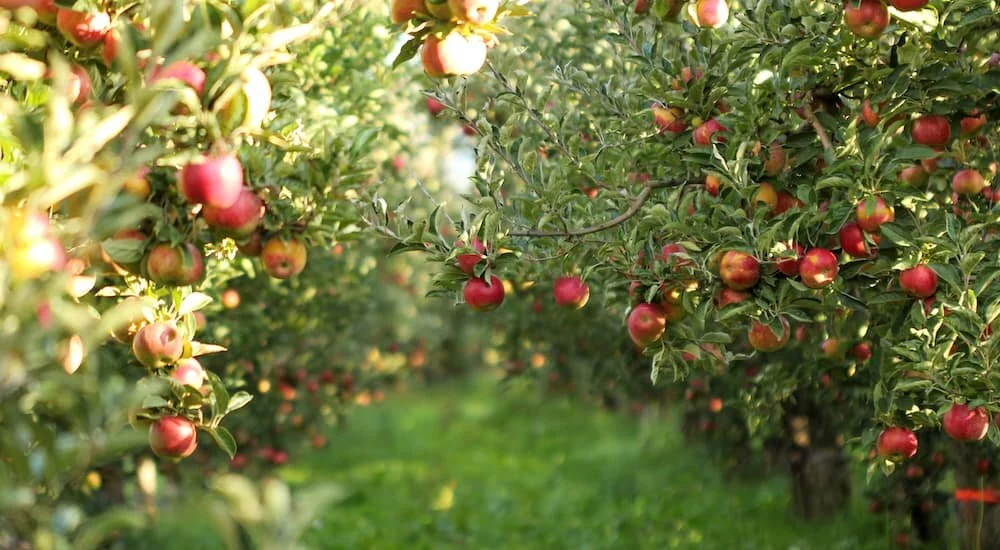Apples
This is the page description.
— OUR APPLES —
Terrace Mountain Orchard offers more than a dozen varieties of apples, all grown right here in our orchard. We invite you to pick your own or visit our Apple Barn to select a bag or two already picked by our staff. Either way, they’re fresh, delicious and nutritious!
Cortland
(available late September) This variety originated in the late 1890s in New York state, a cross between McIntosh and Ben Davis developed at the New York State Agricultural Experiment Station. Sweeter than its McIntosh parent, with only a hint of tartness. Cortland has tender, snow white flesh that resists browning, making it an excellent choice for salads, kabobs and garnishes. The Cortland is available September through April.
Crispin
(available late September) The original name for this exceptional apple was Mutsu, reflecting its Japanese heritage. It was renamed Crispin in the late 1960s and has been gaining fans ever since. Sweet yet refreshing. Very juicy and super crisp. Excellent for eating, sauce, baking and freezing, good for salads and pies. Try Crispins for roasting whole apples or thick slices. They're a wonderful accompaniment for your favorite roast.
Fuji
(available mid-September) Originally developed in Japan in the late 1930s and named after the famous Mt. Fuji, U.S.-grown Fujis began appearing in markets in the 1980s. Fuji is a cross between Ralls Janet and Red Delicious. This variety's popularity is skyrocketing, thanks to its sweet flavor and firmness. Fuji apples are bi-colored, typically striped with yellow and red. They are available year round, beginning in September.
Gala
(available early September) This variety originated in New Zealand, a cross between Kidd's Orange Red and Golden Delicious. The Royal Gala strain was named in honor of Queen Elizabeth II, who deemed it her favorite during a visit to New Zealand. It was brought to the United States in the early 1970s, and is now one of the country's most popular apples. This crispy, juicy, very sweet apple is ideal for snacking. Galas can vary in color, from cream to red- and yellow-striped. U.S.-grown Galas are harvested beginning in mid-July, and are typically available year-round.
Ginger Gold
(available early September) A Virginia grower discovered this apple sprouting amid the ruins of a hurricane-devastated orchard in the late 1960s, and named this greenish-gold, sweet-tart apple after his sweetheart. Its parentage includes Albemarle Pippin, a favorite apple of Thomas Jefferson. This early-season Eastern apple is great for salads, and cooks well too. Available in limited but growing supplies starting in mid-October.
Golden Delicious
(available mid-September) Ever hear that Golden Delicious is the yellow cousin of the popular Red Delicious apple? Actually, they are related in name only, but this honey sweet apple is a special treat all on its own. Golden Delicious is a juicy apple with a mild, sweet flavor. It is crisp and has a light yellow flesh. Golden Delicious are great for adding to salads and are excellent in pies and other baked goods. If you use for baking, you can put less sugar in pies and sauces made from Golden Delicious apples, because of the natural sweetness these apples provide.
Empire
(available late September) Empires premiered in 1966 in the Empire State of New York, a cross between Red Delicious and McIntosh developed by the New York State Agricultural Experiment Station. This crisp, juicy apple has a delightful sweet-tart flavor and creamy white flesh, making it a good all-purpose apple. Stake out your Empire between September and July.
Honeycrisp
(available mid-September) This honey of an apple has a honeyed, mild flavor and a crispness deemed explosive. Crispy, juicy and sweet, this popular newcomer is a cross between a Macoun and a Honeygold. Honeycrisp's skin is a distinctive mottled red over a yellow background, with coarse flesh. This apple is good for snacking, salads and sauce-making, and stores well. Honeycrisp is college educated, developed by the University of Minnesota. Harvested beginning in September, supplies are limited but growing.
Ida Red
(available mid-October) Introduced in 1942, this Idaho Agricultural Experiment Station product is a cross between the Jonathan and Wagener apples. It has a tangy flavor like the Jonathan, but is much larger. It has a bright red skin, and firm texture. This apple is good for snacking and holds its shape ideally for baking. Available from September through June.
McIntosh
(available early September) This is old, well-known variety, was discovered as a chance seedling by John McIntosh in 1811. Its deep red finish sometimes carries a green blush. Juicy, tangy tart McIntosh has a tender, white flesh. It is best used for snacking and applesauce, but some people enjoy its tart flavor in pies as well. (Cook's hints: McIntosh's flesh cooks down easily; if pie making, cut your slices thick or add a thickener). This apple is typically available from September through May.
Macoun
(available mid-September) Extra sweet and aromatic. Very juicy with tender, snow white flesh. Excellent for eating, good for sauce and salads. Try serving Macoun slices with cheese for a sophisticated dessert in the autumn.
Northern Spy
(available mid-October) Skin is green flushed with red stripes where not shaded, and it produces fairly late in the season (late October and beyond). Juicy, crisp and mildly sweet with a rich, aromatic subacid flavor, noted for high vitamin C content. More tart and crunchier than most, it is a good dessert and pie apple that is also used for juice and cider. Further, the Northern Spy is also an excellent apple for storage. (Information compiled from US Apple Association, NY Apple Country and others)
Red Delicious
(available late September) These popular mildly sweet apples are grown across the country but our Red Delicious have the slight tartness so characteristic of apples from New York. Sweet and juicy with crisp, yellow flesh. Excellent for eating and salads. They also look great for a long time so they are the favored choice for holiday centerpieces and wreaths.






